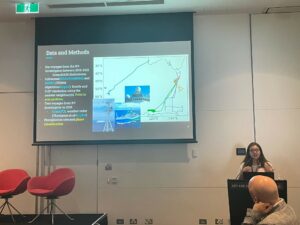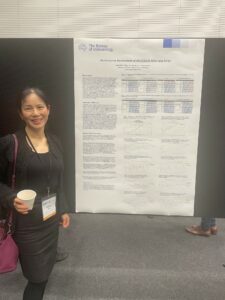HEPEX @ AMOS2022
Contributed by James Bennett, Nick Loveday and Rob Taggart
Guns n’ Roses were in town, and so was HEPEX. For many of us AMOS2022 was the first in-person conference we’d attended since the advent of the pandemic. This alone made it an amazing event – it was wonderful to see old and new faces and feed off the energy of others’ work. Like Slash returning to complete the original lineup, it felt like sinking into your favourite chair. AMOS is the annual conference of the Australian Meteorological and Oceanographic Society and was held in Adelaide this year. So this HEPEX session had more of an atmospheric, um, atmosphere, and was focussed on verification. You can see abstracts for the session here, here and here.
The Bureau of Meteorology had a strong presence in the session: Cass Rogers and Chris Tingwell described how the Bureau is handling their observation network for their new 4-D Var data assimilation methods now being used to improve the Bureau’s ACCESS (Australian Community Climate and Earth-System Simulator) numerical weather prediction (NWP) model. John Sharples and ex-HEPEX blogger Tom Pagano updated us on the Jive real-time verification system and methods the Bureau is using to improve NWP forecasts, with characteristic dry humour. Rob Taggart and Nick Loveday (also Bureau of Meteorology) addressed more formal aspects of forecast verification, highlighting the need for proper verification scores and describing a new multi-categorical score, respectively.
Estefania Montoya Duque giving her terrific talk on verifying reanalyses with ship-borne radar
Hydrological prediction wasn’t forgotten either: Taheer Hamid described how WaterNSW is using economic analyses of past inflows to inform how forecasts might best be used to improve water management. Andrew Schepen (CSIRO) described the co-development of a verification framework between CSIRO and Hydro Tasmania to develop new short-range and subseasonal-to-seasonal ensemble forecasting systems for Hydro’s storages. Richard Laugesen (Bureau of Meteorology) rounded this out with his keynote presentation on how relative utility value (RUV) can be used to demonstrate the effectiveness of streamflow forecasting systems (this will be the subject of a future blog post, so stay tuned!).
Three posters were also presented as part of the session. Reza Khanarmuei and Xiaoxi Wu (both Bureau of Meteorology), presented their work to verify and improve NWP forecasts. Nick Loveday’s poster described his work to verify post-processed NWP forecasts.
The final mention goes to Estefania Montoya Duque, who gave a brilliant talk that brought together atmosphere, ocean and verification. She is pursuing her PhD at the University of Melbourne using ship-borne radar to verify precipitation estimates over the Southern Ocean from the IMERG and ERA5 reanalyses. Among many other interesting findings, Estefania showed that ERA5 tends to drizzle too much over the Southern Ocean, and in some cases can underestimate rainfall intensity by a factor of 3 (!). We look forward to her forthcoming paper on this research.
Outside the auditorium, we had great discussions on many aspects of forecast verification (not least, the many virtues of Tilmann Gneiting!) at Motherlode over fried chicken/cauliflower and at the National Wine Centre for the official conference dinner (perhaps the only venues in Adelaide not blaring ‘November Rain’). It was a reminder of how personal interactions are irreplaceable in science and how much we have to look forward to as we revitalise HEPEX in 2023.
Xiaoxi Wu with her poster on improvements of the new APS4 version of the ACCESS NWP
Mohammadreza (Reza) Khanarmuei presenting his poster on NWP verification with METplus



0 comments